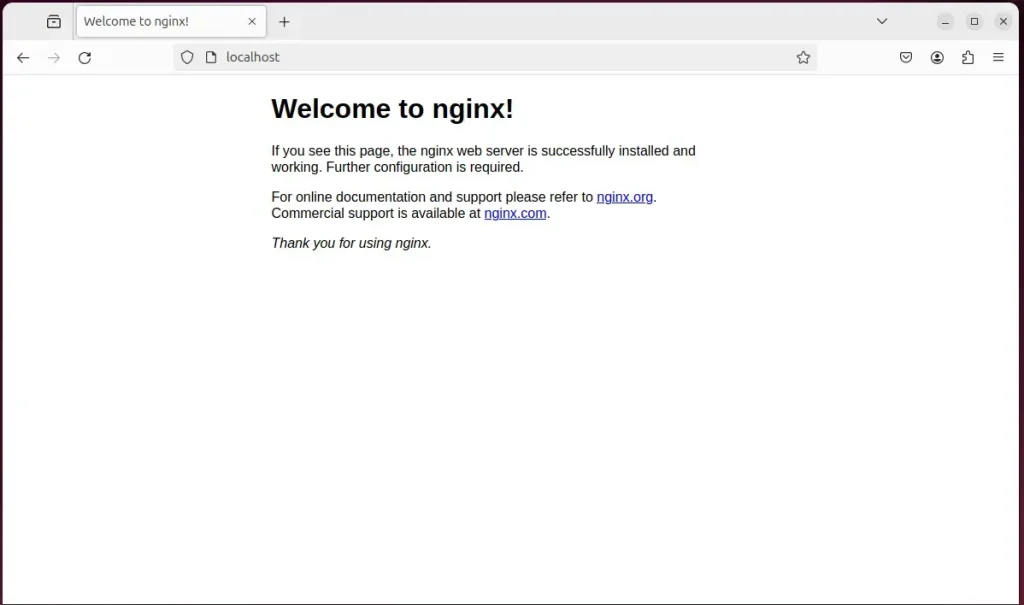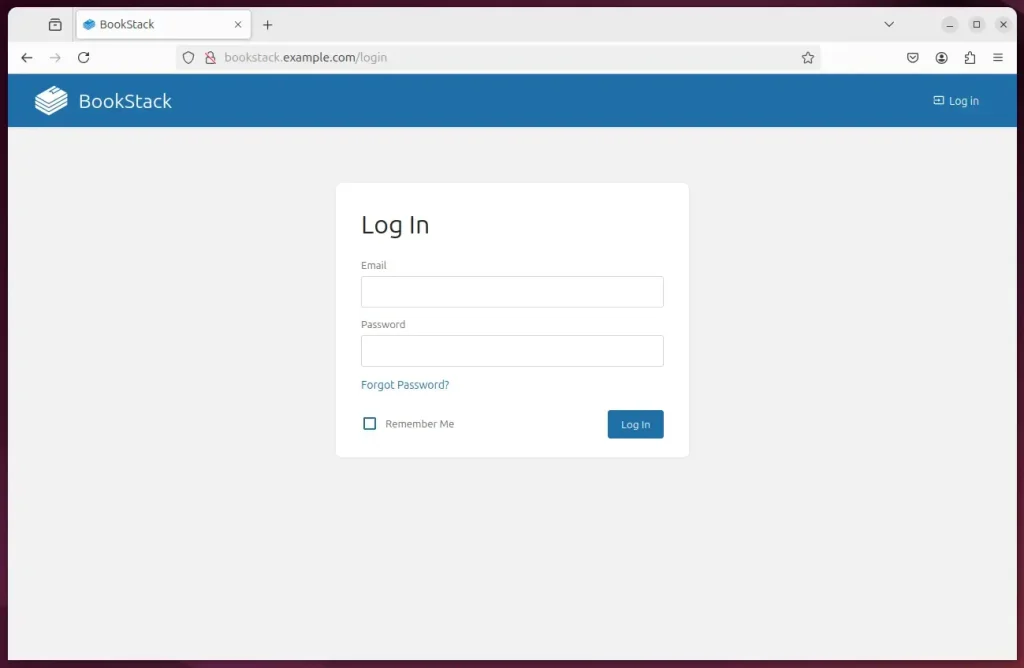This article explains how to install BookStack content management system with Nginx on Ubuntu 24.04.
BookStack is an open-source platform designed to create and manage documentation and wikis. It offers a user-friendly interface, allowing users to easily organize their notes, documents, and collaborative information.
Nginx, a lightweight and highly efficient web server, can handle many concurrent connections, quickly serve static content, and act as a reverse proxy, improving performance and security for your BookStack installation.
Combining BookStack, Nginx, and Ubuntu lets you run a robust server content management system.
Install Nginx HTTP server on Ubuntu
BookStack requires a web server. This post will install and use the Nginx web server to run BookStack.
To do that, open the Ubuntu terminal and run the commands below to install the Nginx web server.
sudo apt update
sudo apt install nginx
Once Nginx is installed, the commands below can start, stop, and enable the Nginx web server to start automatically when your server boots up.
sudo systemctl stop nginx
sudo systemctl start nginx
sudo systemctl enable nginx
You can test the Nginx web server by opening your web browser and browsing to the server’s localhost or IP address.
http://localhost

When you see the Welcome to nginx!, it means the Nginx HTTP server is successfully installed.
Additional help on installing Nginx on Ubuntu is in the link below.
How to install Nginx on Ubuntu
Install the MariaDB database server on Ubuntu
The next component required to run BookStack is a database server. This post will install and use the MariaDB database server.
To install and use the MariaDB database server, use the instructions below.
Open the Ubuntu terminal and run the commands below to install the MariaDB database server.
sudo apt update sudo apt install mariadb-server
Once the MariaDB database server is installed, use the commands below to stop, start, and enable the MariaDB server to start automatically when the server boots.
sudo systemctl stop mariadb sudo systemctl start mariadb sudo systemctl enable mariadb
Run the following commands to validate and test if the MariaDB database server is installed successfully.
sudo mariadb
Once you run the commands above, it will log you onto the MariaDB console and display a message similar to the one below.
Welcome to the MariaDB monitor. Commands end with ; or g. Your MariaDB connection id is 32 Server version: 10.11.2-MariaDB-1 Ubuntu 23.04 Copyright (c) 2000, 2018, Oracle, MariaDB Corporation Ab and others. Type 'help;' or 'h' for help. Type 'c' to clear the current input statement. MariaDB [(none)]>
The message tells you that the server is installed successfully.
Additional help on installing MariaDB.
Create a BookStack database
Upon successfully installing the MariaDB database server, create a blank database on the server specifically for the BookStack application.
As part of the setup, we will create a bookstackdb database and a user account called bookstackdbuser.
Finally, we’ll grant the bookstackdbuser full access to the bookstackdb database.
All the database steps above can be done using the commands below:
But first, log on to the MariaDB database server:
sudo mariadb
Then run the commands below to complete the steps:
CREATE DATABASE bookstackdb CHARACTER SET utf8mb4 COLLATE utf8mb4_general_ci;
CREATE USER bookstackdbuser@localhost IDENTIFIED BY 'type_your_password_here';
GRANT ALL ON bookstackdb.* TO bookstackdbuser@localhost WITH GRANT OPTION;
FLUSH PRIVILEGES;
exit
Ensure to replace ‘type_your_password_here ‘with your password.
Install PHP on Ubuntu Linux
The last component you will need to run BookStack is PHP. The BookStack application is PHP-based and supports the latest versions of PHP.
Then, run the commands below to install the latest PHP version.
sudo apt install php-fpm php-intl php-mysql php-curl php-cli php-zip php-xml php-gd php-common php-mbstring php-xmlrpc php-bcmath php-json php-sqlite3 php-soap php-zip
Additional help on installing PHP
How to install PHP on Ubuntu Linux
Download BookStack files
Let’s begin downloading and configuring the BookStack files on Ubuntu Linux.
First, install Composer, git, and curl packages by running the command below.
sudo apt install git curl
sudo curl -sS https://getcomposer.org/installer | sudo php -- --install-dir=/usr/bin --filename=composer
Then, run the commands below to install Composer and use it to download BookStack content.
cd /var/www/
sudo git clone https://github.com/BookStackApp/BookStack.git --branch release --single-branch
sudo chown -R www-data:www-data /var/www/BookStack/
cd BookStack
sudo -u www-data composer install --no-dev
Next, create the environment configuration file from the example file.
sudo -u www-data mv .env.example .env
sudo -u www-data nano .env
Then, enter the database connection info you made above and configure the APP_URL settings.
APP_URL=http://bookstack.example.com
# Database details
DB_HOST=localhost
DB_DATABASE=bookstackdb
DB_USERNAME=bookstackdbuser
DB_PASSWORD=type_your_password_here
Save and exit.
After that, run the commands below in the BookStack directory to create the application’s unique key and migrate the database.
sudo -u www-data php artisan key:generate
sudo -u www-data php artisan migrate
Next, run the commands below to change Nginx root folder permissions so the BookStack app can function correctly.
sudo chown -R www-data:www-data /var/www/BookStack/
Once you have completed all the above steps, continue configuring the Nginx web server below to serve the BookStack content.
Run the commands below to create a Nginx virtual host file for BookStack.
sudo nano /etc/nginx/sites-available/bookstack.conf
Then, copy and paste the content block below into the Nginx server block.
server {
listen 80;
listen [::]:80;
root /var/www/BookStack/public;
index index.php;
server_name bookstack.example.com;
access_log /var/log/nginx/example.com.access.log;
error_log /var/log/nginx/example.com.error.log;
location / {
try_files $uri $uri/ /index.php?$query_string;
}
location ~ \.php$ {
include snippets/fastcgi-php.conf;
fastcgi_pass unix:/var/run/php/php8.3-fpm.sock;
fastcgi_param SCRIPT_FILENAME $document_root$fastcgi_script_name;
include fastcgi_params;
}
}
Save the file.
Then, run the commands below to enable the virtual host and restart the Nginx server.
sudo ln -s /etc/nginx/sites-available/bookstack.conf /etc/nginx/sites-enabled/
sudo systemctl restart nginx.service
Setup Let’s Encrypt SSL/TLS for BookStack
You may want to install an SSL/TLS certificate to secure your BookStack site. Secure your BookStack installation with HTTPS from Let’s Encrypt.
Please read the post below for additional resources on installing and creating Let’s Encrypt SSL certificates for Nginx.
How to set up Let’s Encrypt SSL certificate for Nginx on Ubuntu Linux
Once you have restarted the Nginx web server, open your browser and browse to the server hostname or IP address defined in the Nginx server block.
http://bookstack.example.com
BookStack should be installed and ready to use.
You can now log in using the default admin details [email protected] with a password of password. You should change these details immediately after logging in for the first time.

That should do it!
Conclusion:
Installing BookStack on an Ubuntu server with Nginx offers an effective solution for managing documentation and wikis. By following the outlined steps, you can ensure a seamless setup process. Here are the key takeaways:
- Comprehensive Setup: Successfully installed Nginx, MariaDB, and PHP to support BookStack functionality.
- Robust Database: Created a dedicated database and user for BookStack, ensuring organized data management.
- Efficient Configuration: Configured Nginx to serve the BookStack application efficiently while handling HTTP requests.
- Security Considerations: We recommend the use of Let’s Encrypt for SSL/TLS certificates to secure your BookStack installation.
- User-Friendly Interface: Gained access to BookStack’s intuitive UI, facilitating easy documentation and information management.
With these steps completed, your BookStack instance is ready for use, allowing you to manage your content effectively and collaboratively.

Leave a Reply